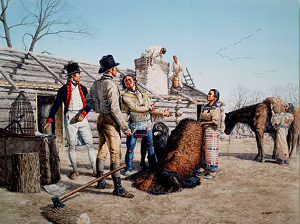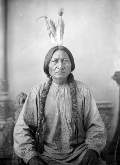The Making of the 50 States: North Dakota
Part 1: In the Beginning Among the Native American tribes living in what is now North Dakota were the Arikara, Assiniboine, Blackfeet, Cheyenne, Chippewa, Cree, Crow, Dakota Sioux, Hidatsa, Lakota Sioux, and Mandan. As he did with so many states in this part of the country, René-Robert Cavelier Sieur, de La Salle claimed the area for France in 1682. The first recorded European visitor to the area was France's Pierre de La Vérendrye, who came from Canada and reached the Missouri River in 1738. A fur trade developed and prospered, facilitated in part by trading posts like those at Fort Clark and Fort Union. As with many other neighboring states, North Dakota was claimed by France, handed to Spain, given back to France, and then finally sold to the United States, in the form of the Louisiana Purchase. (Actually, that land purchase included only part of what is now North Dakota; the southeastern part was owned by Great Britain until 1818. 
The opening of the North Dakota area to American settlement gave the fur trade a boost, as did the report filed by Lewis and Clark after they returned from their visit to the Pacific (having gone through the area in 1804 (building Fort Mandan) and again in 1806). It was in North Dakota that Lewis and Clark met Toussaint Charbonneau and his wife, Sacagawea, both of whom accompanied the Corps of Discovery on its journey west. The first permanent settlement was Pembina, established in 1812 as the result of the influence of fur trader Alexander Henry, Jr. Trade along the Missouri River greatly increased after the 1830s invention of the paddle steamboat. North Dakota was not involved fundamentally in the Civil War but was the location of several violent struggles between Native Americans and American settlers. The U.S. Army had built Fort Abercrombie in 1857. A number of Army expeditions searching for a Dakota chief wanted in connection with an 1862 Minnesota uprising found resistance from Dakota tribes. A pair of 1863 battles (Whitestone Hill and Killdeer Mountain) and on the following year at Badlands forced many Dakota onto reservations. The Army established further posts at Fort Buford and Fort Rice. 
Col. George Armstrong Custer led two expeditions in the North Dakota area, both from Fort Abraham Lincoln. The first was an 1874 reconnaissance mission, out of which he and his men verified the existence of gold in the Black Hills. The second, in 1876, resulted in his defeat and death at Little Bighorn. Sitting Bull, one of the leaders of the force that won that battle, fought on against American settlement, surrendering at Fort Buford in 1881. Next page > The Rest of the Story > Page 1, 2
|
|
Social Studies for Kids
copyright 2002–2024
David White




